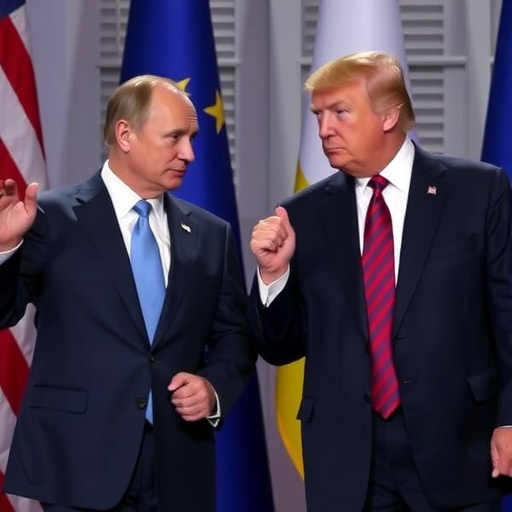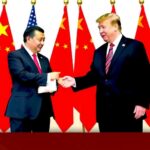Trump Postpones Putin Summit Over Ukraine War: No Meeting Until Peace Deal Secured
In a bold diplomatic maneuver, former U.S. President Donald Trump has indefinitely delayed a highly anticipated summit with Russian President Vladimir Putin, insisting that no face-to-face meeting will occur until a comprehensive peace deal is reached in the ongoing Ukraine war. This decision, announced during a rally in Florida on Saturday, underscores Trump‘s unwavering commitment to resolving the conflict that has ravaged Europe for over two years, drawing sharp reactions from global leaders and analysts alike.
Trump’s statement comes amid escalating tensions in the Ukraine war, where Russian forces continue to advance in eastern regions while Ukrainian troops, bolstered by Western aid, mount fierce resistance. The postponement of the summit—originally floated as a potential post-election olive branch if Trump returns to the White House—signals a shift in U.S.-Russia relations, prioritizing resolution over dialogue. “I’m not sitting down with Putin until there’s a real peace deal on the table,” Trump declared to a cheering crowd. “The Ukraine war has gone on long enough; it’s time for both sides to negotiate seriously.”
This development adds another layer to the complex geopolitical landscape, where the Ukraine war has already claimed over 500,000 lives, displaced millions, and strained global economies through energy crises and food shortages. As Trump positions himself as a potential peacemaker in the 2024 presidential race, his stance could reshape international alliances and influence ongoing peace talks mediated by the United Nations and European Union.
Trump’s Firm Conditions Spark Diplomatic Ripple Effects
Donald Trump’s decision to tie any summit with Putin to a Ukraine peace deal has sent shockwaves through diplomatic circles, highlighting his strategy of leveraging personal diplomacy for high-stakes outcomes. Sources close to Trump’s campaign reveal that the former president views the Ukraine war as a solvable crisis, one that could be ended “in 24 hours” through direct negotiations—a claim he has repeated since his 2016 presidency.
The postponement was first hinted at during Trump’s recent interviews, where he criticized the Biden administration’s handling of the conflict. “We’ve poured billions into Ukraine, and what do we have? More death and destruction,” Trump said in a Fox News appearance last week. By conditioning the summit on a peace deal, Trump aims to pressure both Moscow and Kyiv into concessions, potentially including territorial compromises and security guarantees. Experts note that this approach echoes Trump’s 2018 Singapore summit with North Korea’s Kim Jong-un, where bold rhetoric led to temporary de-escalation.
However, the move isn’t without risks. Russian officials have dismissed Trump’s preconditions as “unrealistic,” with Kremlin spokesperson Dmitry Peskov stating, “President Putin is open to dialogue, but not under ultimatums.” This rhetoric could prolong the Ukraine war, as frontline battles intensify in Donetsk and Kharkiv oblasts. According to the latest reports from the Institute for the Study of War, Russian advances have captured over 1,000 square kilometers since January, while Ukraine’s counteroffensives have relied on advanced U.S.-supplied weapons like HIMARS systems.
Domestically, Trump’s base has rallied behind the decision, viewing it as tough-on-Russia leadership. Polls from Pew Research indicate that 62% of Republican voters support prioritizing a Ukraine peace deal over immediate diplomatic engagements, up from 45% in 2022. Yet, critics argue that sidelining Putin might isolate the U.S. from potential backchannel talks, complicating efforts by mediators like Turkey’s President Erdogan, who has hosted preliminary Ukraine-Russia negotiations.
Reviving Memories of Past Trump-Putin Encounters
The shadow of previous Trump-Putin interactions looms large over this latest diplomatic standoff, providing context for why a summit was even considered in the first place. During his presidency, Trump met Putin multiple times, including at the 2017 G20 summit in Hamburg and the 2018 Helsinki summit, where the two leaders discussed arms control, counterterrorism, and election interference allegations. Those encounters, often criticized for their amiability, yielded mixed results: the Helsinki meeting led to a joint statement on non-interference but no concrete agreements on Syria or Ukraine.
Trump has long portrayed himself as uniquely positioned to broker deals with Putin, citing their “good chemistry.” In his 2021 book The Art of the Deal, Trump alluded to personal rapport as a tool for diplomacy, a theme he revisited in recent speeches. “Putin respects strength, and I’ve shown it before,” he told supporters at the Florida rally. This history fuels speculation that a Trump-led summit could accelerate a peace deal, perhaps involving NATO’s non-expansion pledges—a red line for Moscow since the Ukraine war erupted in February 2022.
Yet, the Ukraine war has fundamentally altered the dynamics. Putin’s full-scale invasion, condemned by the UN General Assembly with 141 votes, has isolated Russia economically through sanctions totaling over $300 billion in frozen assets. Trump’s precondition reflects this shift; unlike pre-2022 summits, he now demands tangible progress, such as a ceasefire along the 1,000-kilometer front line or humanitarian corridors for besieged cities like Mariupol’s remnants.
Analysts from the Council on Foreign Relations point out that past Trump-Putin talks often bypassed Ukraine specifics, focusing instead on bilateral issues. A renewed summit under peace deal terms could integrate Ukraine war resolutions, potentially including reparations estimates at $1 trillion, as cited by Ukrainian President Volodymyr Zelenskyy. This evolution underscores how the conflict has redefined U.S.-Russia engagement, making casual diplomacy untenable.
Global Leaders React to Summit Delay Amid Ukraine Escalations
The international community has responded swiftly to Trump’s announcement, with reactions ranging from cautious support to outright concern over its impact on the Ukraine war. European allies, already fatigued by the conflict’s economic toll— including a 40% spike in natural gas prices since 2021—see Trump’s stance as a potential catalyst for peace. German Chancellor Olaf Scholz praised the conditionality, stating in a Berlin press conference, “Any dialogue with Russia must prioritize ending the suffering in Ukraine.”
Conversely, Ukrainian officials expressed mixed feelings. Zelenskyy, in a virtual address to the European Parliament, welcomed Trump’s focus on a peace deal but urged vigilance: “We appreciate American leadership, but peace cannot come at the cost of our sovereignty.” Kyiv has pushed for a “just peace,” rejecting Russian demands for recognition of annexed territories like Crimea and parts of Donbas, which cover 18% of Ukraine’s land.
In Moscow, the response was predictably defiant. Putin, speaking at a Valdai Discussion Club forum, implied that Trump’s delay shows U.S. inconsistency: “We are ready for talks, but not dictated by election cycles.” This comes as Russia bolsters its military with alliances from Iran and North Korea, supplying drones and artillery shells that have sustained the Ukraine war’s intensity.
Other stakeholders, including China, have remained neutral but watchful. Beijing, which has abstained from UN votes condemning Russia, could play a pivotal role in any peace deal, given its economic leverage over both nations. U.S. Secretary of State Antony Blinken, addressing the delay, emphasized multilateral efforts: “The path to peace in Ukraine lies through coordinated international pressure, not unilateral summits.” These reactions highlight the delicate balance Trump must navigate, where his personal diplomacy intersects with broader alliances like NATO’s $100 billion aid package to Ukraine since 2022.
Pathways to a Ukraine Peace Deal: Challenges and Prospects
As the summit remains on hold, attention turns to the intricate pathways toward a Ukraine peace deal that could unlock Trump-Putin talks. Negotiations have stalled since the March 2022 Istanbul talks, where proposals for neutrality and demilitarization were floated but rejected. Current frameworks, outlined in a recent EU roadmap, include phased ceasefires, prisoner exchanges (over 10,000 POWs held), and reconstruction funding from seized Russian assets.
Trump’s involvement could inject fresh momentum, drawing on his deal-making reputation. Campaign advisors suggest he envisions a “grand bargain” encompassing not just Ukraine but also Middle East stability and Arctic resource sharing. However, obstacles abound: Russia’s insistence on lifting sanctions, Ukraine’s demand for war crimes accountability (with ICC warrants for Putin), and domestic politics in all three nations.
Statistics paint a grim picture of urgency. The World Bank estimates the Ukraine war has pushed 6.5 million refugees into Europe, while global food prices rose 28% in 2022 due to disrupted Black Sea exports. A peace deal could stabilize these trends, potentially reducing inflation by 2-3% worldwide, per IMF projections.
Looking ahead, Trump’s delay might encourage indirect channels, such as U.S.-Russia working groups under UN auspices. If a breakthrough occurs—perhaps via Saudi-hosted talks— it could pave the way for the summit, reshaping the Ukraine war’s trajectory. For now, the world watches as Trump’s precondition hangs over diplomacy, a high-stakes gamble for peace in a fractured global order.
The implications extend beyond immediate talks. A successful peace deal could bolster Trump’s 2024 prospects, portraying him as a resolver of international crises. Failure, however, risks accusations of posturing, prolonging the Ukraine war’s devastation. As winter approaches, with energy vulnerabilities exposed, the pressure mounts for all parties to prioritize resolution over rhetoric.









